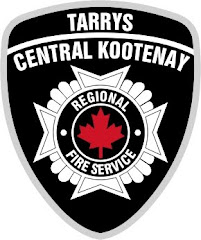A few weeks back we went up to the fire training ground at the Selkirk College campus in Nelson. The training ground has a bunch of natural-gas powered emplacements that can be lit and used for firefighting practice. It has dumpster, wall fire, propane tank, barbeque and car fire emplacements, and it looks like they will be adding a larger bus fire location as well.
The training ground also has a simulation building, built from cargo containers. It’s full of small rooms, furniture, closets, stairwells and other fun stuff. You can build a fire in an enclosed space at the back, filling the building with smoke and heat. We had a little problem getting the fire emplacements running, so we decided to do a Search and Rescue practice run into the building.
Tommy, another Firefighter who joined the department around the same time as I did, and I geared up in our BA’s. The training officer asked if we wanted to have a look around the building, before we went in. Everybody else went inside, but I said no. We won’t get a chance to preview a real structure before we go in, so why do it in training?
After everyone got back, the training officer used a smoke bomb to fill the building, and we headed inside. I’m not claustrophobic. I’ve done SCUBA diving and caving, and I’m not bothered by blackout simulations or wearing SCBA’s. But being in a building were you can’t see anything but smoke still feels a little… close. If you were the slightest bit panicked by tight spaces, I would really not recommend this sort of thing.
Like a good Firefighter, I checked my air before going in. 1900 PSI. Crawling, we worked our way down the upper floor of the structure, checking closets, working our way through hallways and keeping one hand on the right-hand wall. I was the second man, and I know the theory here – keep one hand on the leg of the first guy, and use the fire axe handle to extend your reach and probe for obstructions or people.
Of course, the practice is a bit different. A sofa feels a lot like a person when you are poking it with the handle of an axe. And an axe in a small, confined, obscured area becomes a bit unwieldy. It’s also lots of fun to find your way around. We had a little trouble on the way back, starting down a hallway that we hadn’t come in on.
We made it back out, and it felt like we’d been in there an hour, so I checked my air again. 1400 PSI. We were inside maybe 6 or 7 minutes. It was a totally foreign experience, and I imagine that heat and crackling flames would have made it a lot more stressful. I really enjoyed myself, though. It was a mental and physical challenge, and something that very few people get to do.
It also highlighted to me how critical scenario training like this is – dangerous, unfamiliar environments are easy places to panic or make mistakes in. Hands-on training makes those experiences more familiar, and allow you to use the trained skills. I just wish we had the resources to do this more often – I’d rather have the skills and not need them, than need them and not have them.
Monday, October 5, 2009
Subscribe to:
Post Comments (Atom)


No comments:
Post a Comment